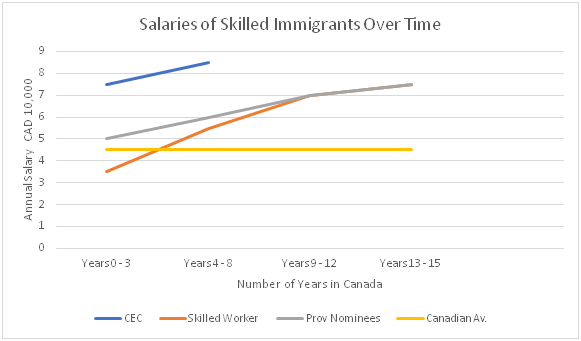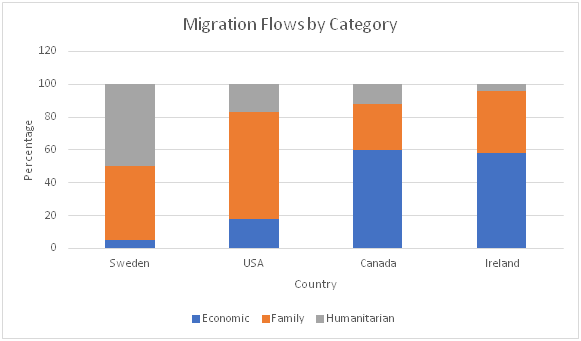Do Immigrants Steal Jobs?

There are those who say immigration hurts Canada and especially hurts native-born Canadians by driving down wages and taking away jobs they would otherwise have if there was little immigration into the country. In order to answer their claims, the first step is to ask what is the reality of immigration and Canada’s economic performance? What does the data show?
There are those who say immigration hurts Canada and especially hurts native-born Canadians by driving down wages and taking away jobs they would otherwise have if there was little immigration into the country. In order to answer their claims, the first step is to ask what is the reality of immigration and Canada’s economic performance? What does the data show?
The second step is to think about wealth and how wealth is created. Whether it’s a fairly stable “pie” that has to be divided up between Canada’s workers, or whether it’s a dynamic set of statistics that are constantly changing, and hopefully growing each year, with the obvious exception of recessions when the economy shrinks over a period of several quarters.
So, let’s start by examining the effect that immigration has on the Canadian economy.
What impact does immigration have on Canada’s economy?
Canadian exports as of 2014 by The Atlas of Economic Complexity / Wikimedia Commons / CC BY-SA 3.0
Very little in fact, is the basic answer. The OECD’s 2018 Report on Canada’s economy states that:
While most studies of the effect on real GDP per capita in Canada conclude that immigration has a small negative effect owing to immigrants having lower earnings on average than the native-born, these studies do not take into account the effects of second-generation Canadians, who, as noted above, have higher levels of education attainment and earnings than other Canadians. Taking these effects into account, the overall impact of immigration on GDP per capita is likely to be positive.
In other words, many immigrants to Canada nowadays are filling in the gap that our slow birth rate produces in the needed supply of younger workers, especially with respect their children who are either born in or mostly raised in Canada. This helps to balance working Canadians against retired Canadians, in order to pay for the retiring Baby Boomer cohort which is starting to put an enormous strain on Canada’s retirement programs – like OAS and the CPP – and also on the country’s healthcare system. What Canada is managing to do is attract higher skilled immigrants with sufficient language skills, work experience, and education through its Express Entry program rather than have to deal with an enormous wave of low-skilled workers that are causing serious problems in several countries in Western Europe, like Germany, Austria, and Sweden.
That’s a crock to put it politely. Here are a few reasons why.
Where Are the Babies?
Birth rate vs death rate in Canada [Public Domain]
Canada has a slowing birth rate, especially among native-born families. The rate is noticeably lower than in the U.S. and is similar to Western European countries which are facing a demographic crisis. Canada needs immigrants in order to merely maintain its population levels, never mind grow its population at a sustainable rate. No immigration or low levels of immigration would mean less workers earning less money overall and a slower rate of GDP growth in Canada.
Canada Attracts Skilled Workers the Economy Needs
By changing to a points-based immigration system with the introduction of Express Entry in 2015, a system that has been and is being successfully used in Australia and New Zealand, Canada accomplishes several things:
Strengthen Global Economic Ties
Canada’s free trade agreements by JayCoop / Wikimedia Commons / CC BY-SA 4.0
Attracting more skilled workers helps to strengthen our ties with trading partners around the globe. Canada is what they call a “Small Open Economy.” We. Need. Trading. Partners. It’s that simple.
Skilled Workers Earn More
While skilled immigrants often have to undergo a period of adaptation to their new home, their earnings in fact do rise over time and in the middle to high income earning groups they end up being greater than the earnings of native-born Canadians. Consider the following graph:
Source: H. Zhang: Current Measures of Immigrant Economic Outcomes and Strategic Enhancement (2014 Longitudinal Immigration Database)
One can see how immigrants in the Economic Class tend to earn more than their Canadian-born counterparts after having lived and worked in Canada for a few years.
Higher Wages Are Good in For the Economy
Immigrants in the middle to upper income groups accumulate higher net-worths over their working lives compared to native-born Canadians. These immigrants can thus add to the pool of savings that our banking system then loans out to entrepreneurs who start businesses that employ people that earn money and buy houses and cars and laptops and hockey skates and donuts and coffee and even beavertails. (What’s a beavertail? It’s a delicious pastry which is now franchised in places like Japan, South Korea, and the UAE and comes from a recipe of the Romanian grandmother of entrepreneur Grant Hooker who started the business with his wife Pamela in the Ottawa area in the late ’70s.)
Consider the following tables:
| Married Families according to Main Income Recipient (MIR) Age | Immigrant Mean Family Wealth | Canadian-born Mean Family Wealth |
|---|---|---|
| Overall | $280,154 | $262,631 |
| MIR 25 years old or younger | $25,007 | $60,452 |
| MIR 26 – 35 years old | $102,267 | $103,087 |
| MIR 36 – 45 years old | $184,464 | $243,558 |
| MIR 46 – 55 years old | $345,595 | $349,893 |
| MIR 56 – 65 years old | $449,547 | $403,179 |
| MIR older than 65 years old | $364,555 | $330,239 |
| Single Families according to Main Income Recipient (MIR) Age | Immigrant Mean Family Wealth | Canadian-born Mean Family Wealth |
|---|---|---|
| Overall | $140,908 | $105,871 |
| MIR 25 years old or younger | $104,601 | $24,797 |
| MIR 26 – 35 years old | $90,940 | $72,876 |
| MIR 36 – 45 years old | $73,159 | $87,218 |
| MIR 46 – 55 years old | $164,803 | $142,287 |
| MIR 56 -65 years old | $235,067 | $163,670 |
| MIR older than 65 years old | $184,247 | $170,944 |
Source: Xuelin Zhang: The Wealth Position of Immigrant Families in Canada
As can be seen in the case of both married and single families, over their working lives immigrant families start out behind native-born Canadians but by around the time the MIR (the Main Income Recipient, or the main breadwinner if you wish) reaches her/his late ’40s or early ’50s, they have surpassed native-born Canadians in terms of their net worth (total assets minus all outstanding debts). In other words, as they move up the income ladder and accumulate increasing amounts of savings and wealth, immigrant families on average end up doing better than native-born Canadians.
Immigrants Start Businesses
According to Statistics Canada’s study – Business Ownership and Employment in Immigrant-Owned Firms in Canada – immigrants have a higher rate of entrepreneurship than native-born Canadians, once they’ve lived in Canada for around 4 to 7 years. As the study says:
In the first few years after entry to Canada, immigrants understandably have relatively low rates of business ownership and job creation compared with the Canadian-born population. But these outcomes change quickly with years spent in Canada, so that after four to seven years, the propensity of immigrants to own a private incorporated business or to be unincorporated self-employed surpasses that of the Canadian-born population.
Yes, as the study also says, immigrant-based businesses tend to be smaller and employ less people than those founded by native-born Canadians, but the level of individual effort and commitment by new Canadians to pay their way contributes to Canada’s prosperity.
Is the Immigrant Wage Handicap Worsening?
There’s another concern that’s been voiced on more than one occasion and it has to do with the effect of an increase in a cohort of immigration – immigrants who land in Canada over a defined period, like 1976 – 1980 – on wages. Specifically, does an increase in immigration produce falling wages in Canada?
The answer depends on whose wages we’re talking about. Here’s a table summarizing the studies that have been done on this issue:
| Canadian Study | Findings of the Studies on Wages and Immigration |
|---|---|
| Aydemir & Borjas (2007) |
|
| Tu (2010) | At a national level, increased immigration after policy changes in the late ’80s did not affect the growth of wages for native-born Canadians. |
| Fougere, Harvey, & Rainville (2011) | If Canada were to increase the inflow of immigrants from 0.75% to 1.0% of the population – from around 280,000 t0 370,000 based on current populations figures – then overall wages for all workers could fall from 0.1% to 0.3%. |
| Hou & Picot (2014) | A 10% increase in immigration is associated with a 0.8% decline in entry-level earnings for immigrant men and a 0.3% decline for immigrant women. |
There’re a few takeaways from this chart:
- The wages of native-born Canadians are not much affected by increases in immigration levels, especially seeing that migrants often have several years of subpar earnings as they adapt to the Canadian workplace.
- Migrant wages, especially lower skilled workers are often hardest hit by increases in competition from newly arrived immigrants.
- Migrant women’s wages are not as affected by increased levels of immigration.
Immigrant Earnings
Now let’s see what the numbers look like for immigrants’ earnings in Canada over their working lives in their adopted country. The indications are disappointing in a key area: the discount that immigrant workers take on their entry-level wages compared to native-born Canadian workers. Consider these numbers:
- In the late ’70s, immigrant male entry-earnings were 85% of Canadian-born entry-earnings.
- In the early 2000s, immigrant male entry-earnings were only 60% of Canadian-born entry-earnings.
Why did immigrant entry-level earnings decline by so much relative to Canadian-born workers?
The main factor seems to be language ability (English and/or French), which was significantly worse with the cohort of immigrants in the early 2000s compared to those from the late ‘70s. Yes, your ability to communicate fluently in either English or French (or both) is one of the main factors, all else being equal, in determining the level of your wages. As we have seen, soft skills are vital in today’s economy, especially in an innovation-based economy where your ability to listen and communicate is what separates you from your co-workers.
Here’s a chart from the OECD study detailing how long it takes someone to raise their Canadian Language Benchmark rating by a single point (for example, from a 6.5 to a 7.5):
| Economics Class – Language Skill | |
|---|---|
| Listening | 370 hours |
| Speaking | 420 hours |
| Reading | 570 hours |
| Writing | 490 hours |
Source: Zhang, Zhong, and Lee: Research Insights in Settlement Services: Uptake, Mobility of Clients and Service Outcomes (2017 IRCC Research and Evaluation Branch)
Let’s assume you can spend 8 hours a week taking English classes. That’s a high number, given the fact that you are assumed to be someone with a full-time permanent job. But even with 8 hours a week, the above chart shows that you need about a year of constant studying and classes to improve your English or French language skills. This is especially true for your reading skills, which are likely to take about 18 months to upgrade. And in today’s innovation-based economy not being up to speed with regards to your reading ability will be a real hindrance to your wage growth. We keep reminding our readers how important it is to upgrade your language skills. This OECD study – which is based on data from IRCC – is living proof of that. And remember, language skills are necessary but not sufficient. They are a way to ensure that you will get paid less of a discount compared to your native-born peers in your area of expertise. You will need your hard (or technical) skills as well, which most Economic Class immigrants possess at fairly high levels.
It’s Not a Pie – It’s a Croissant
Finally, there is the notion that somehow immigrant workers are stealing jobs from native-born Canadians. Given that Canada has one of the world’s most stable economies and has experienced generally good growth rates over the past several decades as immigration levels have been maintained or increased, this idea does not seem to be supported by the evidence. Especially seeing that Canada has a very rigorous immigration system that places emphasis on skills rather than on refugees or on family reunification, compared to some other developed countries. Consider the following chart:
As can clearly be seen, countries like Canada and Ireland (as well Australia, New Zealand, and the UK) focus much more on the Economic Class of migrants in order to attract quality skilled labour to the country in order to provide the foundation for future growth.
And that’s the point. The economy is not a fixed pie that has to be squabbled over in what is called a zero-sum game. Immigrants do not necessarily have to lose in order for native-born Canadians to win. Think of the economy as one heck of a big croissant that’s continually expanding in the crucible of innovation and diversity that is Canada. And as any French-speaker will tell you, croissant means growing.
![Canadian Exports in 2014 By The Atlas of Economic Complexity [CC BY-SA 3.0 (https://creativecommons.org/licenses/by-sa/3.0)], via Wikimedia Commons](https://upload.wikimedia.org/wikipedia/commons/1/16/What_did_Canada_export_in_2014.png)
![Birth rate vs death rate in Canada By Incnis Mrsi [Public domain], from Wikimedia Commons](https://upload.wikimedia.org/wikipedia/commons/thumb/0/02/RNI_1950_CA.svg/640px-RNI_1950_CA.svg.png)
![Canada's free trade deals By JayCoop [CC BY-SA 4.0 (https://creativecommons.org/licenses/by-sa/4.0)], from Wikimedia Commons](https://upload.wikimedia.org/wikipedia/commons/thumb/4/43/FTAs_with_Canada.svg/640px-FTAs_with_Canada.svg.png)

